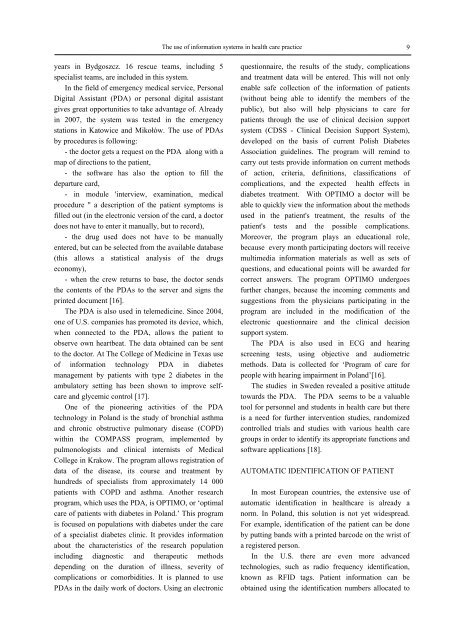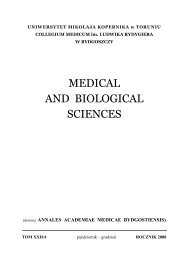Wsparcie spoÅeczne u chorych z miażdżycÄ tÄtnic koÅczyn dolnych
Wsparcie spoÅeczne u chorych z miażdżycÄ tÄtnic koÅczyn dolnych
Wsparcie spoÅeczne u chorych z miażdżycÄ tÄtnic koÅczyn dolnych
Create successful ePaper yourself
Turn your PDF publications into a flip-book with our unique Google optimized e-Paper software.
The use of information systems in health care practice 9<br />
years in Bydgoszcz. 16 rescue teams, including 5<br />
specialist teams, are included in this system.<br />
In the field of emergency medical service, Personal<br />
Digital Assistant (PDA) or personal digital assistant<br />
gives great opportunities to take advantage of. Already<br />
in 2007, the system was tested in the emergency<br />
stations in Katowice and Mikołów. The use of PDAs<br />
by procedures is following:<br />
- the doctor gets a request on the PDA along with a<br />
map of directions to the patient,<br />
- the software has also the option to fill the<br />
departure card,<br />
- in module 'interview, examination, medical<br />
procedure " a description of the patient symptoms is<br />
filled out (in the electronic version of the card, a doctor<br />
does not have to enter it manually, but to record),<br />
- the drug used does not have to be manually<br />
entered, but can be selected from the available database<br />
(this allows a statistical analysis of the drugs<br />
economy),<br />
- when the crew returns to base, the doctor sends<br />
the contents of the PDAs to the server and signs the<br />
printed document [16].<br />
The PDA is also used in telemedicine. Since 2004,<br />
one of U.S. companies has promoted its device, which,<br />
when connected to the PDA, allows the patient to<br />
observe own heartbeat. The data obtained can be sent<br />
to the doctor. At The College of Medicine in Texas use<br />
of information technology PDA in diabetes<br />
management by patients with type 2 diabetes in the<br />
ambulatory setting has been shown to improve selfcare<br />
and glycemic control [17].<br />
One of the pioneering activities of the PDA<br />
technology in Poland is the study of bronchial asthma<br />
and chronic obstructive pulmonary disease (COPD)<br />
within the COMPASS program, implemented by<br />
pulmonologists and clinical internists of Medical<br />
College in Krakow. The program allows registration of<br />
data of the disease, its course and treatment by<br />
hundreds of specialists from approximately 14 000<br />
patients with COPD and asthma. Another research<br />
program, which uses the PDA, is OPTIMO, or ‘optimal<br />
care of patients with diabetes in Poland.’ This program<br />
is focused on populations with diabetes under the care<br />
of a specialist diabetes clinic. It provides information<br />
about the characteristics of the research population<br />
including diagnostic and therapeutic methods<br />
depending on the duration of illness, severity of<br />
complications or comorbidities. It is planned to use<br />
PDAs in the daily work of doctors. Using an electronic<br />
questionnaire, the results of the study, complications<br />
and treatment data will be entered. This will not only<br />
enable safe collection of the information of patients<br />
(without being able to identify the members of the<br />
public), but also will help physicians to care for<br />
patients through the use of clinical decision support<br />
system (CDSS - Clinical Decision Support System),<br />
developed on the basis of current Polish Diabetes<br />
Association guidelines. The program will remind to<br />
carry out tests provide information on current methods<br />
of action, criteria, definitions, classifications of<br />
complications, and the expected health effects in<br />
diabetes treatment. With OPTIMO a doctor will be<br />
able to quickly view the information about the methods<br />
used in the patient's treatment, the results of the<br />
patient's tests and the possible complications.<br />
Moreover, the program plays an educational role,<br />
because every month participating doctors will receive<br />
multimedia information materials as well as sets of<br />
questions, and educational points will be awarded for<br />
correct answers. The program OPTIMO undergoes<br />
further changes, because the incoming comments and<br />
suggestions from the physicians participating in the<br />
program are included in the modification of the<br />
electronic questionnaire and the clinical decision<br />
support system.<br />
The PDA is also used in ECG and hearing<br />
screening tests, using objective and audiometric<br />
methods. Data is collected for ‘Program of care for<br />
people with hearing impairment in Poland’[16].<br />
The studies in Sweden revealed a positive attitude<br />
towards the PDA. The PDA seems to be a valuable<br />
tool for personnel and students in health care but there<br />
is a need for further intervention studies, randomized<br />
controlled trials and studies with various health care<br />
groups in order to identify its appropriate functions and<br />
software applications [18].<br />
AUTOMATIC IDENTIFICATION OF PATIENT<br />
In most European countries, the extensive use of<br />
automatic identification in healthcare is already a<br />
norm. In Poland, this solution is not yet widespread.<br />
For example, identification of the patient can be done<br />
by putting bands with a printed barcode on the wrist of<br />
a registered person.<br />
In the U.S. there are even more advanced<br />
technologies, such as radio frequency identification,<br />
known as RFID tags. Patient information can be<br />
obtained using the identification numbers allocated to

















